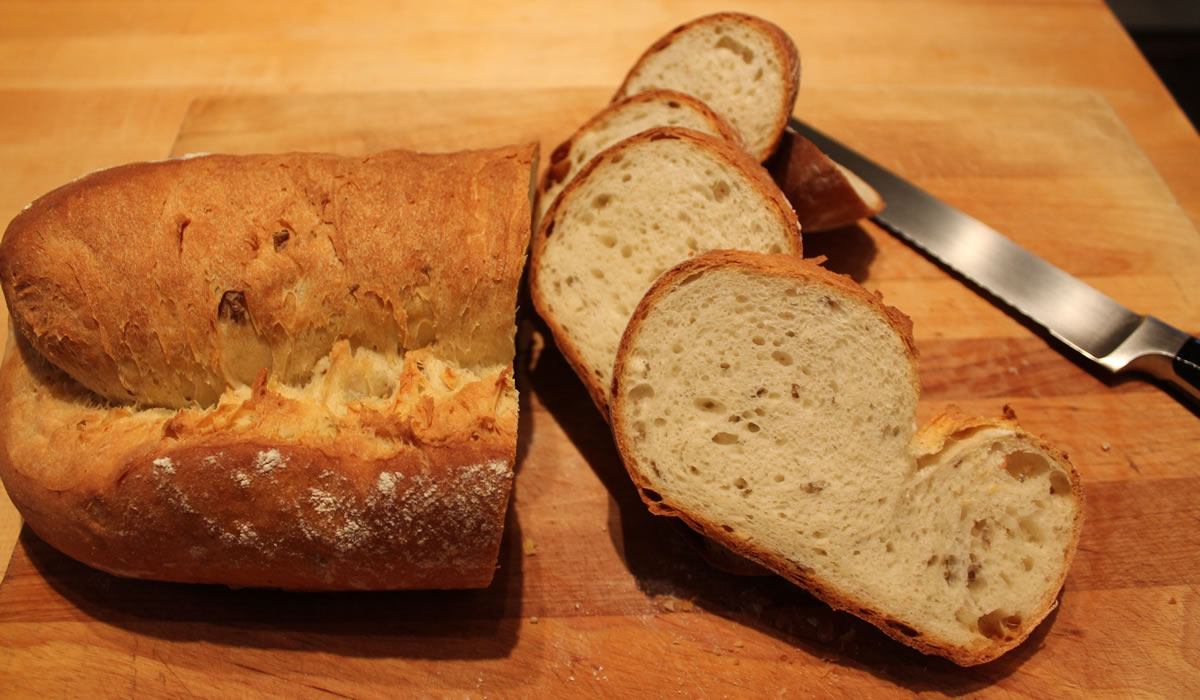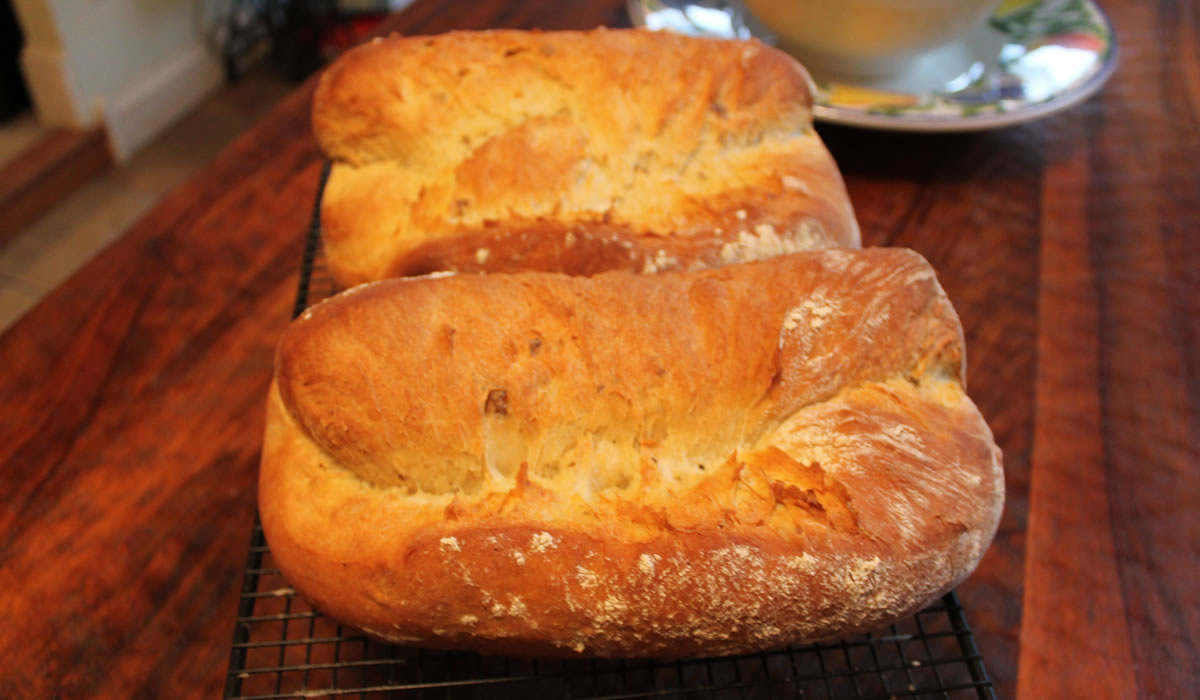Okay, boys and girls… this is a strange recipe. It pretty much contradicts everything I’ve ever known about bread baking – and it came out perfect!
Rustic Potato Bread is made with potatoes that have been boiled in salted water – cut but unpeeled – allowed to dry on the counter, and then worked into a bread dough – all the while looking like it will never happen. The secret here is to trust the recipe. Really.
The recipe comes from Leslie Mackie when she was on Baking With Julia. The PBS show is on reruns on Create TV and, since I have the cookbook, it’s fun to follow along on some of the shows – like when a young Martha Stewart makes a huge wedding cake!
It’s no secret that I’m a huge fan of bread and I’m always up for a new recipe. However, it seems that I’m always making variations on my favorite Pane Pugliese from Carol Field. It’s time to take some of those other recipes I have and start baking!
This was a great one to do. The caveat is to follow the recipe. It doesn’t look like it’s going to come together, but it really does.
It also rises fast. First rise is 20-30 minutes, second rise another 20 and they’re ready to bake.
Rustic Potato Bread
adapted from Leslie Mackie in Baking with Julia
Makes 2 loaves
- 1 1/2 pounds russet potatoes (about 3)
- 4 teaspoons salt
- 1/2 cup tepid reserved potato water (80 to 90 degrees F)
- 1 tablespoon active dry yeast
- 2 tablespoons extra-virgin olive oil
- 4 3/4 cups unbleached all-purpose flour
Cooking the Potatoes.
Scrub the potatoes and cut them into quarters, peel and all. Toss them into a 2 quart pot, cover with water, add 2 teaspoons of the salt, and boil until the potatoes are soft enough to be pierced easily with the point of a knife. Dip a measuring cup into the pot and draw off 1/2 cup of the potato water; reserve. Drain the potatoes in a colander and then spread them out, either in the colander, or on a cooling rack over a jelly-roll pan, and let them cool and air-dry for 20 to 30 minutes. It’s important that the potatoes be dry before they’re mashed.
Mixing the dough.
When the potatoes are cool, stir the yeast into the reserved potato water (if the water is no longer warm, heat it for a few seconds in a microwave oven–it should feel warm to the touch) and allow it to rest for 5 minutes; it will turn creamy.
Meanwhile, turn the cooked potatoes into the bowl of a mixer fitted with the paddle attachment and mash them. With the mixer on low speed, add the dissolved yeast and the olive oil and mix until the liquids are incorporated into the potatoes.
Replace the paddle with the dough hook and, still mixing on low speed, add the flour and the remaining 2 teaspoons of salt. Mix on low speed for 2 to 3 minutes, then increase the speed to medium and mix for 11 minutes more. The dough will be firm at first and soft at the finish. At the start, it will look dry, so dry you’ll think you’re making a pie crust. But as the dough is worked, it will be transformed. It may even look like a brioche, cleaning the sides of the bowl but pooling at the bottom. Have faith and keep beating.
First rise.
Cover the mixing bowl with plastic wrap and allow the dough to rise at room temperature for 20 to 30 minutes, at which point the dough will have risen noticeably, although it may not have doubled.
While the bread is proofing, position a rack in the bottom of the oven and fit it with a baking stone or quarry tiles, leaving a border of at least 1 inch all around. Preheat the oven to 375 degrees F. Place a linen towel on a baking sheet, rub the towel with flour, and set aside; this will be the resting place for the bread’s final rise. Rub a baker’s peel or baking sheet with cornmeal or flour. Fill a spray bottle with water; set aside.
Shaping the dough.
Turn the bread out into a lightly floured surface and, using a dough scraper, cut the dough in half. To shape each half into a torpedo shape, first shape it into a ball and then flatten it into a disk. Starting at the end farthest from you, roll up the dough toward you. When you’re on your last roll, stop and pull the free end of the dough toward you, stretching it gently, and dust its edge with flour. Finish the roll and, if necessary, rock the loaf back and forth a little to taper the ends and form a torpedo, or football.
Second rise.
Place the loaves on the floured towel, seam side down, and cover them with the ends of a towel (or another towel). Let the breads rise at room temperature for 20 minutes.
Baking the bread.
When you’re ready to bake, spray the oven walls with water and immediately close the oven door to trap the steam. Turn the breads out, seam side up, onto the peel or baking sheet and transfer them to the oven. Spray the oven with water again and bake the loaves for 45 to 50 minutes, or until the crust is very brown, the loaves sound hollow when thumped on the bottom, and, the most important test, the interior temperature measures 200 degrees F when an instant-read thermometer is plunged into the center of the loaves. Remove the loaves from the oven and cool on a rack at least 20 minutes before slicing. While you should wait for the bread to firm up in the cooling process, slather this bread with butter while it’s still warm is a great treat.
The bread has almost a sourdough texture and flavor. It is seriously good. Light, great crumb and chewy crust. My perfect bread.
Now, to find more of her recipes!
Stay tuned.


